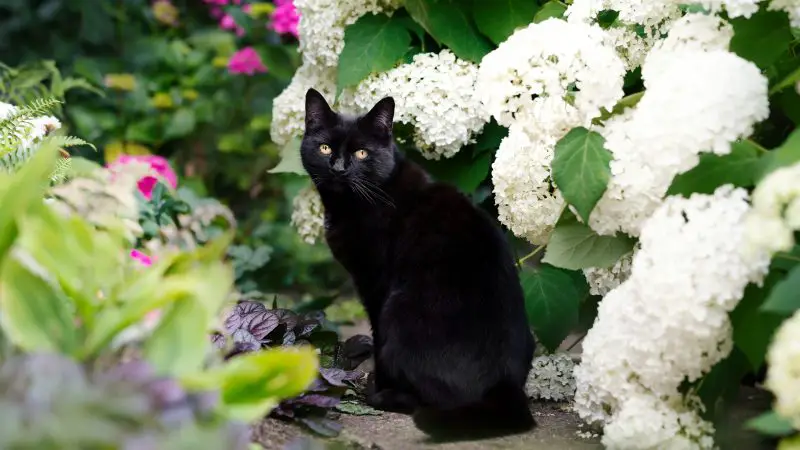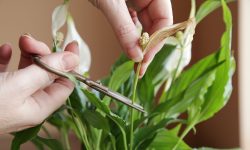Hydrangeas are beloved for their large, lush blooms and classic beauty in garden landscapes, but for pet owners—especially those with curious cats—there’s a critical question to consider: are hydrangea plants poisonous to cats? The answer is yes, hydrangeas can be toxic if ingested by felines. Understanding the risks, recognizing the symptoms of poisoning, and knowing how to create a safe environment for both your plants and your pets is essential.
This comprehensive guide explores the science behind hydrangea toxicity, outlines the symptoms of exposure in cats, and offers practical strategies for prevention and treatment. Whether you’re an avid gardener or a cat lover living in a hydrangea-filled neighborhood, this article will help you protect your furry companions while still enjoying the beauty of your garden.
Understanding Hydrangea Toxicity in Cats

Why Hydrangeas Are Considered Toxic
Hydrangeas contain a natural compound called amygdalin, which can release cyanide when metabolized. This cyanogenic glycoside is found in all parts of the plant, including leaves, stems, flowers, and even the bark. While humans would need to consume large quantities to experience toxic effects, cats have a much lower threshold for cyanide poisoning.
Because cats are small in size and often nibble on plants out of curiosity or boredom, even small amounts of hydrangea can pose a health risk. The risk is even higher for kittens or elderly cats with compromised immune systems or underlying health conditions.
Which Parts of the Plant Are Dangerous
Every part of the hydrangea plant holds some level of toxicity, though the leaves and flower buds are typically the most potent. Ingestion of even a small quantity may lead to clinical signs of poisoning, especially if a cat chews on fresh growth or fallen leaves.
The toxicity level can vary depending on the plant’s health, the season, and the environment. For instance, young leaves may have higher concentrations of cyanogenic glycosides than older ones. Dried hydrangea parts used in floral arrangements may also remain toxic if chewed on.
Recognizing Signs of Hydrangea Poisoning in Cats
Early Symptoms to Watch For
Recognizing early signs of hydrangea poisoning in cats can make a crucial difference in treatment outcomes. The most common initial symptoms include drooling, mild vomiting, and a sudden lack of interest in food. These may appear within 30 minutes to a few hours after ingestion. Cats might also paw at their mouth or show signs of oral discomfort due to irritation caused by chewing on the plant.
Lethargy is another early red flag. If your normally active cat becomes unusually still or withdrawn after being near a hydrangea, it’s important to consider plant exposure as a potential cause. In some cases, slight diarrhea or soft stools may follow as the plant compounds affect the digestive system.
Promptly noticing and acting on these mild symptoms gives you the best chance of avoiding more serious complications like respiratory issues or severe dehydration. Always err on the side of caution and contact a veterinarian if your cat shows any sudden, unexplained changes in behavior or appetite.
Severe or Advanced Symptoms
When a cat ingests a larger quantity of hydrangea or if treatment is delayed, symptoms can quickly progress from mild to severe. Advanced poisoning may involve intense vomiting, persistent diarrhea, and signs of abdominal pain such as vocalizing, crouching, or guarding the belly. Dehydration can develop rapidly, especially if fluid loss is not replaced.
Neurological signs may also appear in serious cases. These can include confusion, disorientation, tremors, or even seizures, which indicate that toxins are affecting the nervous system. Difficulty breathing or a noticeably slow or irregular heartbeat are critical warning signs that require emergency care.
At this stage, the risk of organ stress increases, especially in cats with preexisting conditions. Immediate veterinary intervention is essential to stabilize the cat, prevent long-term damage, and support recovery. Never wait for symptoms to worsen—early emergency care can be lifesaving.
Immediate Actions to Take If a Cat Eats Hydrangea
When to Call the Veterinarian
If you suspect that your cat has ingested any part of a hydrangea plant, it is essential to contact your veterinarian right away. Do not wait for symptoms to worsen. Provide your vet with information about the amount and part of the plant ingested, the timing, and any symptoms you’ve observed.
Veterinarians may recommend inducing vomiting, administering activated charcoal to absorb toxins, or providing intravenous fluids to flush the system. Treatment is most effective when initiated early, ideally within the first few hours of exposure.
Emergency Home Care Steps
While you wait for veterinary help or are en route to the clinic, keep your cat calm and away from further plant access. Do not attempt to induce vomiting unless specifically instructed by a veterinarian, as this can cause additional complications.
If your cat has vomited or defecated in the home, be sure to wear gloves when cleaning, and dispose of the waste carefully to prevent other pets from exposure. Keep your cat in a quiet, warm, and comfortable space until professional care is available.
How to Prevent Hydrangea Exposure in Cats
Creating Physical Barriers
The most effective way to prevent plant poisoning is to block access. If you grow hydrangeas in your yard, consider fencing off that area or planting them in raised beds with physical barriers. For indoor arrangements or potted hydrangeas, keep them well out of reach, preferably in rooms your cat cannot access.
Using hanging planters or wall-mounted displays may also reduce the risk. Always consider a cat’s ability to climb or jump, especially in indoor spaces.
Training and Environmental Enrichment
Cats often chew on plants out of boredom, so offering alternative enrichment can help deter this behavior. Provide safe chew toys, cat grass, and climbing structures to redirect their interest. Behavioral training using scent deterrents such as citrus or vinegar around plant areas can be effective for some cats.
Introducing positive reinforcement when your cat ignores the plants can reinforce safe behavior. For persistent chewers, supervised time outdoors or designated plant-free play zones may be necessary.
Safe Alternatives to Hydrangeas for Cat-Friendly Gardens
Non-Toxic Plant Substitutes
If you love the look of hydrangeas but want a safer garden, there are many cat-friendly plants that offer similar texture and color without the toxic risk. Plants like roses, snapdragons, zinnias, and sunflowers are non-toxic to cats and can fill out a garden bed beautifully.
For indoor décor, consider using silk hydrangeas or other artificial floral arrangements that mimic the beauty of fresh blooms without the danger. Always verify plant safety with reputable pet-toxicology lists before introducing new greenery into your home or garden.
Monitoring Plant Purchases and Gifts
Staying vigilant about new plant additions is crucial when living with cats. Always research the toxicity of any plant before buying it, especially those with showy blooms like hydrangeas, lilies, or tulips, which are common yet dangerous to pets. When receiving plants as gifts, inspect the species label or ask the giver directly to identify the plant type. If you’re unsure, isolate the plant in an area off-limits to your cat until proper identification confirms its safety.
It’s also wise to inform friends and family that you maintain a pet-safe home, so they can be mindful when selecting gifts. By proactively screening all new greenery, you prevent accidental exposure and ensure your cat’s environment remains secure and non-toxic.
Long-Term Health and Monitoring After Exposure
Follow-Up Veterinary Care
Once your cat has received initial treatment for hydrangea poisoning, follow-up care is essential to ensure a full recovery and prevent complications. Your veterinarian may recommend keeping your cat under observation for several hours or even overnight, especially if symptoms were moderate to severe. Monitoring will help detect delayed effects, such as liver stress or neurological signs, which might not appear immediately.
After being discharged, your cat may be sent home with medications to support the digestive system or control symptoms like nausea. Your vet might also advise a bland diet for a few days to ease gastrointestinal recovery. Make sure your cat stays hydrated and avoids any further exposure to toxic plants.
You should schedule a follow-up appointment if your cat experienced severe symptoms or if you’re noticing unusual behavior such as continued vomiting, lack of energy, or loss of appetite. Blood work may be recommended to assess liver and kidney function, especially in older cats or those with preexisting health conditions.
It’s also a good time to reevaluate your home or garden environment. Removing hydrangeas from accessible areas, switching to pet-safe plants, and training your cat to avoid chewing greenery are all helpful long-term steps. Consistent veterinary follow-up not only ensures your cat’s health but also helps you build a safer environment going forward.
Creating a Cat-Safe Plant Environment
Establishing a cat-safe plant environment starts with removing all known toxic plants, including hydrangeas, from areas your cat can access. Opt for non-toxic alternatives like spider plants, calatheas, or parlor palms to bring greenery indoors without risking your pet’s health. Place any questionable plants on high shelves or behind barriers if removal isn’t possible.
Consider enriching your cat’s surroundings with safe, chewable greenery like cat grass or catnip to reduce their interest in houseplants. Using deterrent sprays or citrus scents around your plants can also discourage curious nibbling. Training and environmental adjustments together create a space where your cat can safely explore without danger.
Myths and Misconceptions About Hydrangea Poisoning
“My Cat’s Been Around Hydrangeas for Years Without Issues”
Some pet owners assume that because their cat has shown no interest in hydrangeas before, they never will. But cats are unpredictable, and behaviors can change due to stress, age, illness, or environment. Never rely on past behavior as a predictor of future safety.
Even a single bite under the right conditions can trigger toxicity, so it’s better to err on the side of caution. Keep toxic plants out of reach even if your cat has never interacted with them before.
“Dried Hydrangeas Are Harmless”
Dried hydrangeas are generally considered harmless because the toxic compounds, particularly cyanogenic glycosides, degrade significantly as the plant material dries out. The drying process reduces the potency of these chemicals, making accidental ingestion by cats less risky. However, while the danger is lower, curious cats that chew on dried flowers may still experience mild gastrointestinal upset or choking hazards due to the plant’s brittle texture. It’s best to keep dried arrangements out of reach, especially if your cat is known to nibble on houseplants or decor.
Frequently Asked Questions About Hydrangea and Cat Safety
Are hydrangea plants toxic to cats even if they only chew a little?
Yes, even a small nibble of hydrangea leaves or flowers can expose your cat to cyanogenic glycosides, the compound that releases cyanide when metabolized. While a minor chew may only result in mild symptoms such as drooling, nausea, or vomiting, it’s still considered toxic. The severity depends on the amount ingested and your cat’s size and health.
What symptoms should I watch for if I suspect my cat ate hydrangea?
Common signs of hydrangea poisoning in cats include vomiting, diarrhea, lethargy, drooling, and lack of appetite. In more serious cases, symptoms may progress to rapid breathing, weakness, or even seizures. If your cat shows any of these symptoms, contact your veterinarian immediately for treatment advice.
Are certain types of hydrangeas more dangerous than others?
All varieties of hydrangea contain the same core toxic compounds and should be treated with equal caution. Whether it’s bigleaf, oakleaf, panicle, or climbing hydrangeas, they all pose a similar level of risk to cats. No hydrangea variety is known to be completely pet-safe.
Is it safe to keep dried hydrangeas around cats?
Dried hydrangeas are less toxic than fresh ones because the drying process reduces the potency of the cyanogenic compounds. However, they may still cause mild digestive irritation if chewed, and their brittle texture could present a choking hazard. It’s best to keep dried floral arrangements out of your cat’s reach to be completely safe.
What should I do if my cat has ingested part of a hydrangea plant?
Act quickly by removing any remaining plant material from your cat’s mouth and observing their behavior closely. Contact your vet or a pet poison control center for immediate guidance. Be prepared to provide details such as how much your cat may have eaten, when it happened, and any symptoms that have appeared. Early intervention can make a significant difference in recovery.
Conclusion
While hydrangeas may be a gardener’s favorite, they pose real risks to curious feline companions. Knowing that all parts of the plant contain toxins harmful to cats is the first step in protecting your pet. Recognizing the symptoms of poisoning and acting quickly can make all the difference in treatment outcomes. By choosing safe alternatives, creating plant-free zones, and educating yourself on plant toxicity, you can enjoy a beautiful home and garden without compromising your cat’s health.
Balancing a love of plants with responsible pet ownership is entirely possible when you make informed choices. Let this guide be your trusted reference for keeping your cat safe and your garden blooming.






